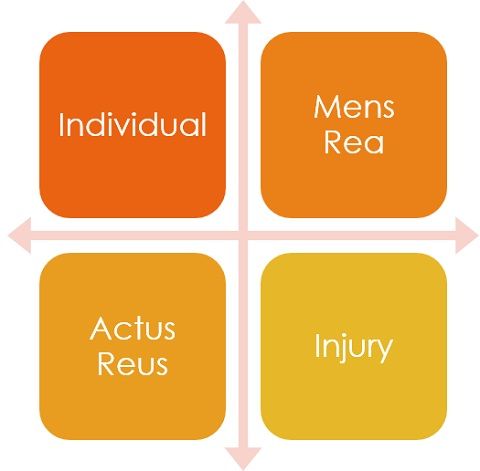 In the simplest sense, deviance implies the ‘rule-breaking’ behaviour, especially the one which deviates from a socially or culturally accepted norm. Deviance is commonly juxtaposed with a crime, which is nothing but a public wrong.
In the simplest sense, deviance implies the ‘rule-breaking’ behaviour, especially the one which deviates from a socially or culturally accepted norm. Deviance is commonly juxtaposed with a crime, which is nothing but a public wrong.
Crime implies an illegal which is worthy of societal condemnation and punishment, because it not just harmful to an individual, but the public at large. There are various types of crimes such as – personal crimes, property crimes, victimless crimes, whitecollar crimes, juvenile delinquency, cybercrime, violation of public safety, etc.
With the progression of time, the rate of crime throughout the world has increased, resulting from various situations and causes. In this article, we will talk about the difference between deviance and crime.
Content: Deviance Vs Crime
Comparison Chart
| Basis for Comparison | Deviance | Crime |
|---|---|---|
| Meaning | Deviance is when there is a non-conformity concerning the well established social and cultural norms and principles. | Crime implies any illegal act or omission, which amounts to the violation of the law, often prosecuted by the state and punishable by law. |
| Documentation | Not written or documented | Well- documented |
| Severity | Not severe | Severe |
| Control | Social organizations and groups | Police and judiciary |
| Results in | Negative social reactions | Punishment |
| Offender | Offender is stigmatized | May receive legal sanctions |
| Change | Norms differ from one culture to another. | Law is the same in different societies. However, the penalty differs with respect to crime. |
Definition of Deviance
Deviance can be understood as the divergence from those standards and norms which are widely accepted by society. It is a behaviour which is labelled as ‘abnormal’ by the people of the society. It covers a range of socially condemned behaviour – any type of conduct that evokes the social penalty, which can be a mild criticism or a capital punishment.
Put it another way, whether or not an act or behaviour is regarded as deviant, depends greatly on the way people look and label that act or behaviour. In essence, the deviance is decided on the basis of social setting or the context in which the deviance happens. Smoking in a public place is an example of deviance.
Further, the behaviour that is deemed as ‘deviant’ may change with time, i.e. with the development of society, its principles and norms are also modified. And so, what is called ‘deviant behaviour’ previously, may not be considered in future.
In addition to this, it is not necessary that what is labelled as ‘deviant’ in one society, is considered as ‘deviant’ in other societies as well. This means, the acts included in a ‘deviant behaviour’ may differ across societies and cultures.
What are Norms?
Norms are the rules which guide the members of the society about what is to be done and what should not be done in a particular situation. Whenever there is a deviation from these norms, it is called as deviance. Norms are of two types:
- Formal Norms: It covers laws and rules, which indicates the formal standards that must be applied in a particular circumstance. Punishments are defined, for deviations (if any).
- Informal Norms: Informal norms differ from one group to another, and no punishment is defined for deviations.
Definition of Crime
Crime refers to any unlawful act or negligence causing physical or psychological harm to someone, often forbidden and punishable by the statute. It is detrimental to the welfare of the public, or to the interest of the state and so, it is prosecuted by the state. The punishment for committing a crime can be fine or imprisonment or both.
In the commission of a crime four stages are involved: 
Crime is the offensive act which breaks the statutory law, as well as it is strongly opposed by society.
Examples: Murder, rape, robbery, theft, burglary, childhood abuse, antisocial behaviour, domestic abuse, sexual harassment, terrorism, cybercrime, hate crime, fraud, etc. are some of the common examples of crime.
The definition of crime varies from one country to another, however, there are certain acts which are considered a crime in all the countries of the world.
Causes of Crime
We all are aware of the fact that no person is criminal by birth. It is the circumstances and environment which make him/her perform a criminal act, prohibited by law. These causes can be social, economical, psychological or biological. These are discussed as under:
- Social Causes
- Family disorganization
- Upbringing of the person
- Defective education
- Hype created by media
- Drinking and drug use
- Unhappy marriages and dowry system
- Social disorganization
- Economic Causes
- Poverty
- Unemployment
- Industrialization and urbanization
- Psychological causes
- Intellectual weakness
- Mental diseases
- Characteristics of personality
- Emotional instability
- Biological causes
- Age
- Gender
- Body Type
Elements of Crime
There are four elements of the crime:
- Individual: An individual is the most important element of the crime who intends to and is ready for the commission of the crime.
- Mens Rea: It refers to ‘guilty mind’. Criminal intent is present in every crime.
- Actus Reus: It implies ‘guilty act’. Crime is often supported by a criminal act.
- Injury: It is often accompanied by an injury or harm, which can be mental, physical or material.
Key Differences Between Deviance and Crime
The differences between deviance and crime are discussed in the points below:
- Deviance alludes to a behaviour, which does not adhere to the norms and values of the society and if it is discovered, it may result in negative sanctions. On the other hand, crime refers to the intentional commission or omission of an act which is considered as socially harmful or dangerous, and punishable by law.
- The acts covered in deviance are not written or documented anywhere, whereas crimes and its types are well-written or documented in the criminal code.
- When it comes to severity, deviance is less severe in comparison to crime.
- Deviance is often controlled by social organizations and groups. As against, police and judiciary are there to control the crime in society by punishing the wrongdoer.
- Deviance results in negative sanctions, wherein those who do not comply with society’s norms and values are often criticized. In contrast, crime leads to punishment, which can be life imprisonment or penalty or both.
- In the case of deviance, the offender is stigmatized, i.e. condemned by society. On the contrary, in the case of crime, the offender may receive legal sanctions.
- The difference in norms can be found across cultures, and so we can say that if a certain act is regarded as deviant in one culture, it is not necessary that it is deviant in another culture also. In contrast, laws are almost the same in all the countries of the world, however, the penalty for the crime may differ.
Conclusion
To sum up, deviance refers to the breaking of contextual, social and cultural norms and standards, by a person. On the contrary, crime refers to the offence which is against the law.






Ishak says
It is impressive
Ajayi oluwadunsin says
It’s really understandable🌟🌟🌟🌟🌟
Meigeida Blessing says
This site is extremely beneficial to me in my course of study .